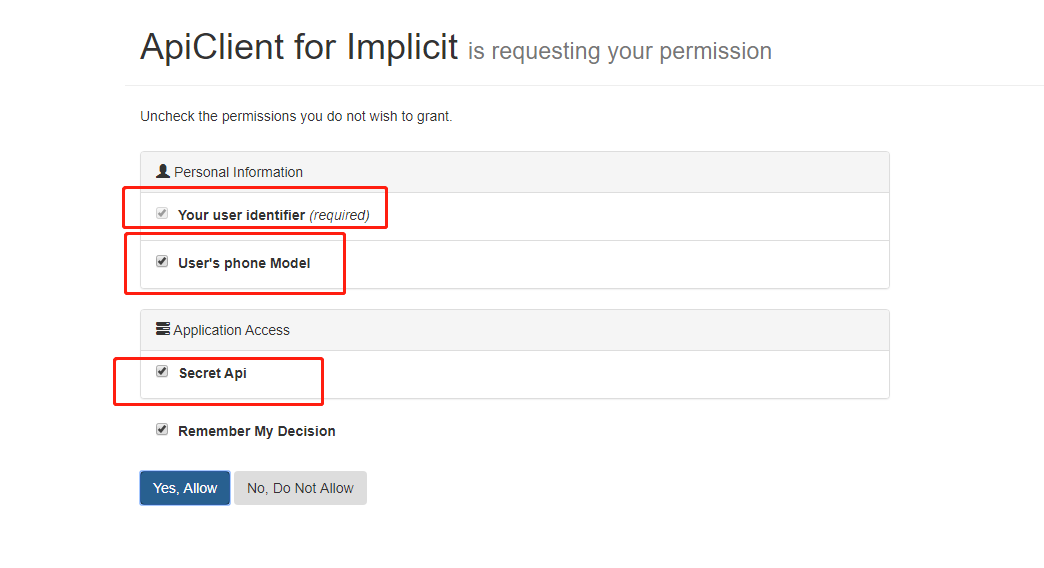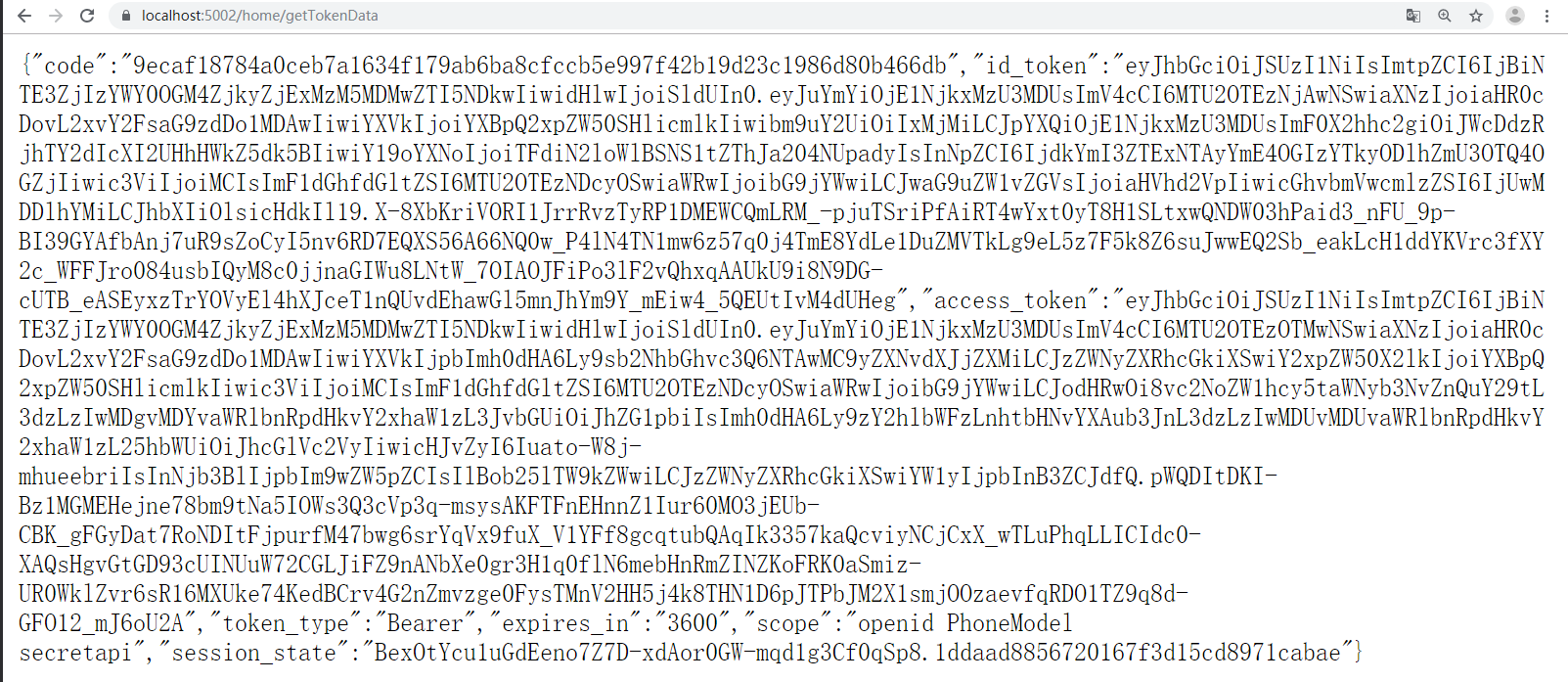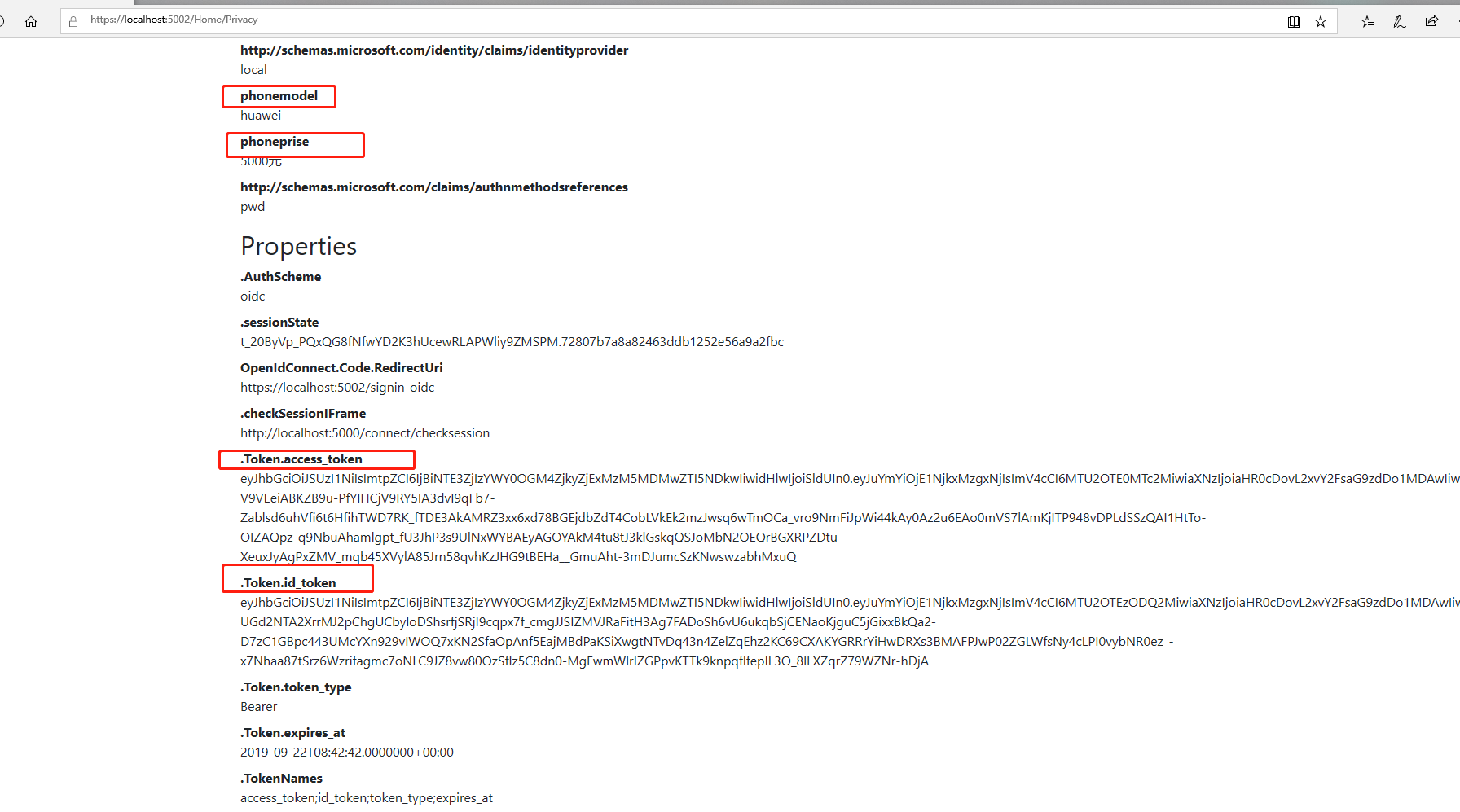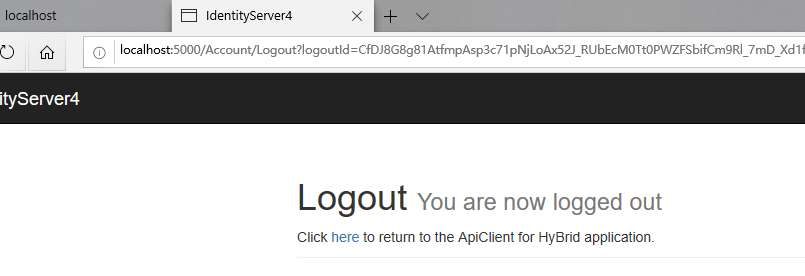接上一篇:IdentityServer4实现OAuth2.0四种模式之授权码模式
前面写的四种OAuth2.0实现模式只涉及到IdentityServer4的OAuth2.0特性,并没有涉及到OenId方面的。OpenIdConnect是OAuth2.0与OpenId的结合,并加入了一个重要的概念:id_token。我们之前所讲的token是用于访问授权的access_token,而id_token是用于身份验证的,作用完全不同,这一点要区分开来。access_token是OAth2.0特性,而id_token是OpenIdConnect方案为改善OAuth2.0方案在身份验证方面的薄弱而加入的特性。
客户端获取Id_token与隐藏模式和授权码模式一样,都是通过redirect_url参数返回的,所以前面的四种模式中的客户端模式与密码模式不支持获取id_token,而授权码模式受限于流程,必需先取得Code才能取到token,所以不能直接支持获取id_token,如果需求是使用授权码模式,同时又需要id_token,OpenIdConnect支持第五种模式:混合模式(Hybrid),就是基于隐藏模式与授权码模式的结合。
一,IdentityServer服务配置
1)添加IdentityResouces
之前的OAuth2.0四种模式已经接触过ApiResouces,ApiResources作用是用于标志Api接口域,与Client配合决定了一个access_token所能访问的api区间,并且允许随access_token携带一些指定的用户Claim。IdentityResources是用于决定了一个id_token可以携带那些用户的身份信息(Claim),其中,如果要从IdentityServer取得id_token,名为"openid"的IdentityResource是必需的
- 使用IdentityServer4定义好的IdentityResource
IdentityServer.Config.GetIdentityResources
public static IEnumerable<IdentityResource> GetIdentityResources()
{
return new IdentityResource[]
{
new IdentityResources.OpenId()
};
}
IdentityResources.OpenId的实现源码如下
public OpenId()
{
Name = IdentityServerConstants.StandardScopes.OpenId;
DisplayName = "Your user identifier";
Required = true;
UserClaims.Add(JwtClaimTypes.Subject);
}
实际上new IdentityResources.OpenId()等效于:
new IdentityResource(IdentityServerConstants.StandardScopes.OpenId,"Your user identifier",new List<string>(){JwtClaimTypes.Subject})
或者
new IdentityResource("openid","Your user identifier",new List<string>(){ "sub"})
所用的重载方法说明最后一个参数List<string>决定了这个IdentityResource携带的Claim,“sub”是Client中定义的Subject属性。
// 摘要:
// Initializes a new instance of the IdentityServer4.Models.IdentityResource class.
//
// 参数:
// name:
// The name.
//
// displayName:
// The display name.
//
// claimTypes:
// The claim types.
//
// 异常:
// T:System.ArgumentNullException:
// name
//
// T:System.ArgumentException:
// Must provide at least one claim type - claimTypes
public IdentityResource(string name, string displayName, IEnumerable<string> claimTypes);
IdentityServer4预定义了OenId,Profile,Email,Phone,Addrss这5个IdentityResource,其中Profile是比较重要的,他默认可携带包括用户的名字、生日、个人网站等信息。Profile映射的Claim的源码如下
{ IdentityServerConstants.StandardScopes.Profile, new[]
{
JwtClaimTypes.Name,
JwtClaimTypes.FamilyName,
JwtClaimTypes.GivenName,
JwtClaimTypes.MiddleName,
JwtClaimTypes.NickName,
JwtClaimTypes.PreferredUserName,
JwtClaimTypes.Profile,
JwtClaimTypes.Picture,
JwtClaimTypes.WebSite,
JwtClaimTypes.Gender,
JwtClaimTypes.BirthDate,
JwtClaimTypes.ZoneInfo,
JwtClaimTypes.Locale,
JwtClaimTypes.UpdatedAt
}},
- 添加自定义的IdentityResource
尽管IdentityServer定义好了这么多IdentityResource,但肯定不能包含所有用户信息。比如我需要在id_token中携带用户手机型号和用户手机价格二个Claim。可以这样自定义一个IdentityResource。
new IdentityResource("PhoneModel","User's phone Model",new List<string>(){ "phonemodel","phoneprise"})
2)将IdentityResource添加到IdentityServer
IdentityServer.StartUp
var builder = services.AddIdentityServer()
//身份信息资源
.AddInMemoryIdentityResources(Config.GetIdentityResources())
//API授权资源
.AddInMemoryApiResources(Config.GetApis())
//客户端
.AddInMemoryClients(Config.GetClients())
//添加用户
.AddTestUsers(Config.GetUsers());
3)配置用户的Claim信息
new TestUser()
{
//用户名
Username="apiUser",
//密码
Password="apiUserPassword",
//用户Id
SubjectId="0",
Claims=new List<Claim>(){
new Claim(ClaimTypes.Role,"admin"),
new Claim(ClaimTypes.Name,"apiUser"),
new Claim("prog","正式项目"),
new Claim("phonemodel","huawei"),
new Claim("phoneprise","5000元"),
}
},
4)配置隐藏模式客户端允许访问该IdentityResource
在前边的四种模式中只有隐藏模式支持直接获取id_token
new Client()
{
//客户端Id
ClientId="apiClientImpl",
ClientName="ApiClient for Implicit",
//客户端授权类型,Implicit:隐藏模式
AllowedGrantTypes=GrantTypes.Implicit,
//允许登录后重定向的地址列表,可以有多个
RedirectUris = {"https://localhost:5002/auth.html"},
//允许访问的资源
AllowedScopes={
"secretapi",
IdentityServerConstants.StandardScopes.OpenId,
"PhoneModel"
},
//允许将token通过浏览器传递
AllowAccessTokensViaBrowser=true,
//允许ID_TOKEN附带Claims
AlwaysIncludeUserClaimsInIdToken=true
}
5)添加混合模式客户端并配置AllowedSopes
new Client()
{
AlwaysIncludeUserClaimsInIdToken=true,
//客户端Id
ClientId="apiClientHybrid",
ClientName="ApiClient for HyBrid",
//客户端密码
ClientSecrets={new Secret("apiSecret".Sha256()) },
//客户端授权类型,Hybrid:混合模式
AllowedGrantTypes=GrantTypes.Hybrid,
//允许登录后重定向的地址列表,可以有多个
RedirectUris = {"https://localhost:5002/auth.html"},
//允许访问的资源
//允许访问的资源
AllowedScopes={
"secretapi",
IdentityServerConstants.StandardScopes.OpenId,
"PhoneModel"
},
AllowOfflineAccess = true,
AllowAccessTokensViaBrowser=true
}
二,隐藏模式获取id_token
先来回顾一下隐藏模式怎么请求access_token的
根据OAuth2.0协议,隐藏模式获取access_token需要传的参数如下所示。
client_id:客户端Id redirect_uri=重定向Url,用户登录成功后跳回此地址 response_type=token,固定值,表示获取token scope=secretapi,此token需要访问的api
接受参数的地址则是IdentityServer的Discover文档中的authorization_endpoint节点。把参数和地址拼接成以下地址:http://localhost:5000/connect/authorize?client_id=apiClientImpl&redirect_uri=https://localhost:5002/auth.html&response_type=token&scope=secretapi,直接访问,会跳转到用户登录页面, 确认后,浏览器将会自动跳转到redirect_url。
获取id_token也是同样的方法,但要注意以下四点
- response_type:隐藏模式支持三种response_type,上面获取access_token已经使用了一种,第二种是获取id_token:id_token。第三种是同时获取access_token和id_token:token id_token
- scope:上面的scope值"scretapi"是一个ApiResource,我们要获取Id_token,必需加入"openid",这是一个IdentityResource。其它的profile,email等按需添加。
- 除开上面的四个参数外,还需要添加一个参数:nonce。这个参数作用是协助你验证这个id_token是否由你自己发出的,可以是一个随机值,也可以是你自己的请求特征加密字符串,会随id_token一并返回供你验证。
- 可以选择性添加一个参数:response_mode。这个参数的作用是指定id_token传到redirect_Url的方法。支持三种方法:
1,query,用于获取授权码,通过url的Query部份传递。如(http://redirect_url.com?code=)。支持授权码模式客户端
2,fragment。和隐藏模式获取access_token一样,通过url的fragment部份传递,如(http://redirect_url.com#token=&id_token=)。支持隐藏模式和混合模式客户端
3,form_post模式,通过form表单(x-www-form-urlencoded)Post到指定url。支持混合模式客户端
根据这四点注意事项,请求url就变成了这样
http://localhost:5000/connect/authorize?client_id=apiClientImpl&redirect_uri=https://localhost:5002/auth.html&response_type=token%20id_token&scope=secretapi%20openid%20PhoneModel&nonce=123&response_model=fragment
使用之前创建apiUser登录成功后出现如下授权界面

三个红色的方框代表请求的三个scope。
同意授权后,将会跳转回redirect_url,id_token和access_token都获取到了

在jwt.io中解析一下这个id_token
{
"nbf": 1569059940,
"exp": 1569060240,
"iss": "http://localhost:5000",
"aud": "apiClientImpl",
"nonce": "123",
"iat": 1569059940,
"at_hash": "PJZyIPRkonv7BWTF42asJw",
"sid": "4b2901045d883a8ba7cf6169b976a113",
"sub": "0",
"auth_time": 1569059940,
"idp": "local",
"phonemodel": "huawei",
"phoneprise": "5000元",
"amr": [
"pwd"
]
}
jwt.io中基本支持所有平台对jwt格式的解析和验证,详见https://jwt.io/
三,混合模式获取id_token
1,使用fragment方式
混合模式获取Id_token与隐藏模式获取id_token大体相同,只有以下二点要注意
- 把client_id改成第一步创建的混合模式客户端id
- 隐藏模式支持三种response_type:token、id_token、token id_token,分别用于请求access_token,id_token以及同时请求二者。而混合模式支持四种:code,code token,code id_token,code token id_token。可用于请求code,id_token,access_token以及同时请求三者。
根据这两点,混合模式的请求url变成了
http://localhost:5000/connect/authorize?client_id=apiClientHybrid&redirect_uri=https://localhost:5002/auth.html&response_type=code token id_token&scope=secretapi openid PhoneModel&nonce=123&response_mode=fragment
用户登录并授权后重定向到redirect_url

可以看到code,id_token,access_code都返回了。拿到code后可以根据code去获取access_token用于访问被保护的api,参考之前的文章:IdentityServer4 实现OAuth2.0授权码模式。也可以直接拿返回的acess_token用,直接返回的access_token由于是和隐藏模式一样以url参数带过来的,为安全考虑,这个access_code的有效时间很段,默认是一个小时。
2,使用form_post方式
先在IdentityMvc项目新建一个Mvc控制器,用于接收post数据请求。
TokenData类用于包装从IdentityServer处Post回来的token数据
public class TokenData
{
public string code { get; set; }
public string id_token { get; set; }
public string access_token { get; set; }
public string token_type { get; set; }
public string expires_in { get; set; }
public string scope { get; set; }
public string session_state { get; set; }
}
HomeController.GetTokenData,用于identityserver的redirect_url
[HttpPost]
public IActionResult GetTokenData(TokenData data)
{
return new JsonResult(data);
}
建好控制器后,把该控制器的访问路径添加IdentityServer的混合模式客户端的RedirectUris
new Client()
{
AlwaysIncludeUserClaimsInIdToken=true,
//客户端Id
ClientId="apiClientHybrid",
ClientName="ApiClient for HyBrid",
//客户端密码
ClientSecrets={new Secret("apiSecret".Sha256()) },
//客户端授权类型,Hybrid:混合模式
AllowedGrantTypes=GrantTypes.Hybrid,
//允许登录后重定向的地址列表,可以有多个
RedirectUris = {"https://localhost:5002/auth.html","https://localhost:5002/home/gettokendata"},
//允许访问的资源
//允许访问的资源
AllowedScopes={
"secretapi",
IdentityServerConstants.StandardScopes.OpenId,
"PhoneModel"
},
AllowOfflineAccess = true,
AllowAccessTokensViaBrowser=true
}
构造请求url。把response_mode设置为form_post,把redirect_url设置为控制器路径
http://localhost:5000/connect/authorize?client_id=apiClientHybrid&redirect_uri=https://localhost:5002/home/getTokenData&response_type=code token id_token&scope=secretapi openid PhoneModel&nonce=123&response_mode=form_post

四,id_token应用:单点登录
id_token包含了用户在openid和用户基本信息,这表明了该用户是有来源的,不是黑户口,如果op(openid provider)值得依赖,第三方客户端完全可以通过解析id_token获取用户信息允许用户登录,而不需要用户重新注册账户,重新登录。
对于web应用来说,实现思路一般是这样的:用户打开页面后,先在Cookie里查询有没有id_token信息,如果有,验证该id_token,验证成功则允许访问,验证失败或者Cookie里没有存储id_token则去op请求id_token,用户在op登录成功并授权后,op返回id_token到第三方应用后,第三方应用把id_token存储到cookie里,用户下次再打开页面就走重新验证id_token过程。如何验证id_token,请参考https://jwt.io/
按时这个思路,可以在任何平台实现单点登录。如果你用的是asp.net core Mvc平台,微软已经把一切都用中间件封装好了,只需要几行简单的配置代码。
测试步骤:
1,由于asp.net core的OpenIdConnect验证方案默认会添加"openid"以及"profile"两个IdentityResource的请求权限,所以需要在IdentityServer添加这两个IdentityResource
IdentityServer.Config
public static IEnumerable<IdentityResource> GetIdentityResources()
{
return new IdentityResource[]
{
new IdentityResources.OpenId(),
new IdentityResources.Profile(),
new IdentityResource("PhoneModel","User's phone Model",new List<string>(){ "phonemodel","phoneprise"})
};
}
把这两个请求权限授权Client
IdentityServer.Config.GetClients
AllowedScopes={
"secretapi",
IdentityServerConstants.StandardScopes.OpenId,
IdentityServerConstants.StandardScopes.Profile,
"PhoneModel"
}
2,由asp.net core的OpenIdConnect验证方案默认的登录重定向地址为signin-oidc,所以把这个地址加入到Client的RedirectUris
RedirectUris = {"https://localhost:5002/auth.html","https://localhost:5002/home/gettokendata","https://localhost:5002/signin-oidc"},
附asp.net core OpenIdConnect验证方案默认设置源码,有几个地方需要注意:
CallbackPath:用于登录重定向地址
SingedOutCallbackPath:注销登录回调地址,后边我们加入注销功能时会用到这个地址
RemoteSignOutPath:注销登录重定向地址
Scope.Add("openid")和Scope.Add("profile")解释了上面第一步为什么要添加这两个IdentityResource。
Microsoft.AspNetCore.Authentication.OpenIdConnect
public OpenIdConnectOptions()
{
CallbackPath = new PathString("/signin-oidc");
SignedOutCallbackPath = new PathString("/signout-callback-oidc");
RemoteSignOutPath = new PathString("/signout-oidc");
Events = new OpenIdConnectEvents();
Scope.Add("openid");
Scope.Add("profile");
ClaimActions.DeleteClaim("nonce");
ClaimActions.DeleteClaim("aud");
ClaimActions.DeleteClaim("azp");
ClaimActions.DeleteClaim("acr");
ClaimActions.DeleteClaim("iss");
ClaimActions.DeleteClaim("iat");
ClaimActions.DeleteClaim("nbf");
ClaimActions.DeleteClaim("exp");
ClaimActions.DeleteClaim("at_hash");
ClaimActions.DeleteClaim("c_hash");
ClaimActions.DeleteClaim("ipaddr");
ClaimActions.DeleteClaim("platf");
ClaimActions.DeleteClaim("ver");
// http://openid.net/specs/openid-connect-core-1_0.html#StandardClaims
ClaimActions.MapUniqueJsonKey("sub", "sub");
ClaimActions.MapUniqueJsonKey("name", "name");
ClaimActions.MapUniqueJsonKey("given_name", "given_name");
ClaimActions.MapUniqueJsonKey("family_name", "family_name");
ClaimActions.MapUniqueJsonKey("profile", "profile");
ClaimActions.MapUniqueJsonKey("email", "email");
_nonceCookieBuilder = new OpenIdConnectNonceCookieBuilder(this)
{
Name = OpenIdConnectDefaults.CookieNoncePrefix,
HttpOnly = true,
SameSite = SameSiteMode.None,
SecurePolicy = CookieSecurePolicy.SameAsRequest,
IsEssential = true,
};
}
3,修改IdentityMvc的Privacy视图控制器,使其必需经过id_token验证后方能访问
IdentityMvc.HomeController
[Microsoft.AspNetCore.Authorization.Authorize]
public IActionResult Privacy()
{
return View();
}
4,修改Privacy视图,展示id_token信息
Privacy.cshtml
@{
ViewData["Title"] = "Privacy Policy";
}
<h1>@ViewData["Title"]</h1>
<h2>Claims</h2>
<dl>
@foreach (var claim in User.Claims)
{
<dt>@claim.Type</dt>
<dd>@claim.Value</dd>
}
</dl>
5,配置客户端
IdentityMvc.StartUp.ConfigureServices
services.AddAuthentication(opt=> {
//默认验证方案
opt.DefaultScheme = "Cookies";
//默认token验证失败后的确认验证结果方案
opt.DefaultChallengeScheme = "oidc";
})
//先添加一个名为Cookies的Cookie认证方案
.AddCookie("Cookies")
//添加OpenIdConnect认证方案
.AddOpenIdConnect("oidc", options =>
{
//指定远程认证方案的本地登录处理方案
options.SignInScheme = "Cookies";
//远程认证地址
options.Authority = "http://localhost:5000";
//Https强制要求标识
options.RequireHttpsMetadata = false;
//客户端ID(支持隐藏模式和授权码模式,密码模式和客户端模式不需要用户登录)
options.ClientSecret = "apiSecret";
//令牌保存标识
options.SaveTokens = true;
//添加访问secretapi域api的权限,用于access_token
options.Scope.Add("secretapi");
//请求授权用户的PhoneModel Claim,随id_token返回
options.Scope.Add("PhoneModel");
//使用隐藏模式
options.ClientId = "apiClientImpl";
//请求返回id_token以及token
options.ResponseType = OpenIdConnectResponseType.IdTokenToken;
});
IdentityMvc.Start.Config
app.UseCookiePolicy();
app.UseAuthentication();
app.UseMvc(routes =>
{
routes.MapRoute(
name: "default",
template: "{controller=Home}/{action=Index}/{id?}");
});
注意:UseAuthentication必需在UseMvc前面。
6,访问https://localhost:5002/Home/Privacy,会重定向到IdentityServer登录界面

用户授权后重定向回Mvc客户端,已经进入Privacy视图了。

7,上面是隐藏模式测试,试一下混合模式,把ClientId改成混合模式Client的Id,ResponseType改成CodeIdTokenToken
services.AddAuthentication(opt=> {
//默认验证方案
opt.DefaultScheme = "Cookies";
//默认token验证失败后的确认验证结果方案
opt.DefaultChallengeScheme = "oidc";
})
//先添加一个名为Cookies的Cookie认证方案
.AddCookie("Cookies")
//添加OpenIdConnect认证方案
.AddOpenIdConnect("oidc", options =>
{
//指定远程认证方案的本地登录处理方案
options.SignInScheme = "Cookies";
//远程认证地址
options.Authority = "http://localhost:5000";
//Https强制要求标识
options.RequireHttpsMetadata = false;
//客户端ID(支持隐藏模式和授权码模式,密码模式和客户端模式不需要用户登录)
options.ClientSecret = "apiSecret";
//令牌保存标识
options.SaveTokens = true;
//添加访问secretapi域api的权限,用于access_token
options.Scope.Add("secretapi");
//请求授权用户的PhoneModel Claim,随id_token返回
options.Scope.Add("PhoneModel");
//使用混合模式
options.ClientId = "apiClientHybrid";
//请求返回code,id_token以及token
options.ResponseType = OpenIdConnectResponseType.CodeIdTokenToken;
});
8,加入注销登录功能
8.1 配置IdentityServer 客户端的PostLogoutRedirectUris属性,值为第2步讲的SingedOutCallbackPath值
IdentityServer.Config.GetClients
//允许登录后重定向的地址列表,可以有多个
RedirectUris = {"https://localhost:5002/auth.html","https://localhost:5002/signin-oidc"},
//注销登录的回调地址列表,可以有多个
PostLogoutRedirectUris = { "https://localhost:5002/signout-callback-oidc" },
8.2,在IdentityMvc项目的HomeController添加一个新的视图控制器,用于注销登录
public IActionResult Logout()
{
return SignOut("Cookies", "oidc");
}
8.3,把这个控制器加入布局页的菜单
<li class="nav-item">
<a class="nav-link text-dark" asp-area="" asp-controller="Home" asp-action="Index">Home</a>
</li>
<li class="nav-item">
<a class="nav-link text-dark" asp-area="" asp-controller="Home" asp-action="Privacy">Privacy</a>
</li>
<li class="nav-item">
<a class="nav-link text-dark" asp-area="" asp-controller="Home" asp-action="Logout">Logout</a>
</li>
登录后访问Privacy页面,然后访问Logout视图,会重定向到IdentityServer执行注销逻辑

9,利用access_token访问被保护的Api
IdentityMvc.HomeController.Detail
[Microsoft.AspNetCore.Authorization.Authorize]
public async Task<IActionResult> Detail()
{
var client = new HttpClient();
var token =await HttpContext.GetTokenAsync("access_token");
client.SetBearerToken(token);
string data = await client.GetStringAsync("https://localhost:5001/api/identity");
JArray json = JArray.Parse(data);
return new JsonResult(json);
}
访问https://localhost:5002/home/detail,获取access_token后请求被保护的api并显示api返回结果。

示例中的客户端数据、资源数据、用户数据都是放在Config类中,如果这些数据需要实时配置,可以与Sql结合实现,下一篇IdentityServer4结合Mysql